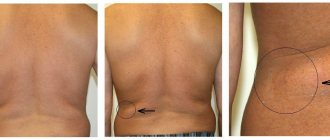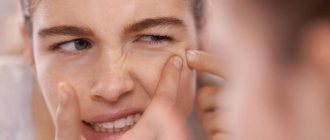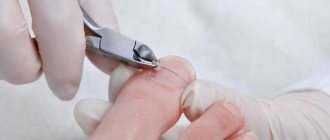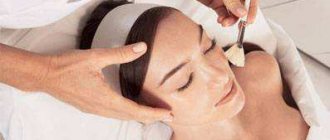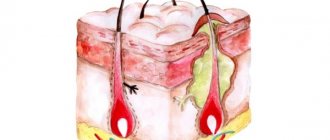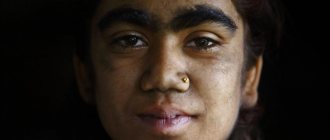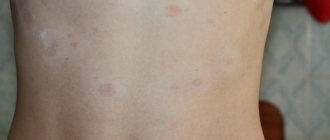At-risk groups
Total alopecia is most often observed in representatives of the stronger sex. However, this does not mean that the disease does not occur among the female part of the population.
And yet, in women, alopecia of this type occurs less frequently than in men due to the physiological structure of the scalp.
Hair follicles in women are located in deeper layers of the skin than in men, which contributes to their greater protection from the effects of negative factors.
Total alopecia develops in people regardless of age . There are cases of complete hair loss in children (for certain reasons).
Symptoms
A clinically important symptom of alopecia is hair loss. Pathology manifests itself both in the form of small focal lesions and in the form of rapid loss of entire hair.
The symptoms of baldness directly depend on the form and type of the disease.
The focal form is accompanied, accordingly, by local hair loss, with round or oval areas of baldness.
The affected area increases significantly over time.
Hair growing at the edges of the lesions becomes thinner and brittle. Signs of vitiligo and onychodystrophy are added to the symptoms.
After a few months, new hair appears in place of the lost hair, which will also fall out in a couple of weeks, and the balding areas will become even larger. Alopecia will take on a total form, involving eyelashes and eyebrows in the pathological process.
Ophiasis, as a form of baldness, begins with the appearance of lesions whose skin surface is smooth and shiny.
The baldness zones are ribbon-like, with a large extent. The disease occurs as a malignant disease and develops against the background of dysfunction of the endocrine system. For example, it is typical for people suffering from hypothyroidism or adrenal insufficiency.
With traumatic total alopecia, no pronounced symptoms are observed; areas where hair is completely absent are located next to areas covered with intact hair.
Significant sign of baldness in men
Symptoms of hereditary alopecia most often occur in children. When studying the hair structure, follicular atrophy is noted in any area of the skin.
A characteristic sign of hereditary baldness is the presence of the disease in several family members.
Androgenetic alopecia is characterized by rapid progression, usually hair loss begins in the forehead area, and then the problem spreads to the crown and back of the head.
Diagnostics
If signs of total alopecia are detected, the patient consults a trichologist . To make an accurate diagnosis, the doctor uses various diagnostic methods.
The patient is advised to take a blood test for hormone levels and undergo phototrichoscopy, which allows one to assess the condition of the hair follicles.
In addition, the doctor evaluates the history of illnesses suffered by the patient (it is quite possible that the cause of total baldness lies in one of them).
If the cause of alopecia is genetic factors , in which the patient has a complete absence of hair follicles (or their dysfunction, insufficient degree of development), diagnosing the disease does not make sense, since the cause of the disease is more than clear.
Complications and consequences
The consequences of total alopecia can be very sad. Complete hair loss can ruin not only your appearance. While some men are still able to perceive a bald crown philosophically, total alopecia in women turns into a real disaster. Personal life and career suffer, character deteriorates, and real depression may develop.
It is difficult for children to cope with baldness. Many of them become outcasts in the children's group, an object of ridicule.
In men, total alopecia can also negatively affect the image, uncertainty develops, and neurotic disorders may arise.
In addition, total alopecia often indicates the general condition of the body, being a symptom of hormonal disorders, which will have other, much more terrible consequences. That is why it is necessary to promptly contact a trichologist who can determine whether baldness is the only problem or an external manifestation of a complex problem.
Alopecia totalis is an aggravated form of patchy baldness that can lead to complete and long-term hair loss over the entire scalp. And if for men this situation is more or less acceptable, then total hair loss in women and children causes enormous panic. Let's look at the causes of the disease and methods of treating this disease.
Reasons for development
Unfortunately, the exact reasons that lead to the development of total baldness have not been fully established. However, most experts believe that factors such as:
- Heredity . In some cases, the child has insufficient development (or complete absence) of hair follicles from birth. Accordingly, the necessary conditions for the formation of hair are absent.
- Dysfunction of the immune system leads to disruption of the hair follicles and their weakening.
- Unfavorable living conditions (for example, poor ecology).
- Extensive injuries to the scalp (for example, extensive burns or frostbite).
- Hormonal disorders (in particular, increased levels of dihydrotestosterone, which negatively affects the condition of the hair follicles).
- Some infectious and non-infectious diseases (oncology, fungal infections, disorders of the circulatory and endocrine systems), inflammatory processes.
- Pathological conditions during pregnancy (for example, severe toxicosis).
- Previously transferred operations .
- Intoxication of the body caused by the negative effects of chemicals and radioactive substances.
- Poor nutrition (diets that exclude the intake of protein foods).
- Disorders in the functioning of the nervous system.
Read the following articles on our website about the types of alopecia:
- Telogen effluvium hair loss - what is it? Is treatment used for this type of alopecia?
- How difficult is it to cure cicatricial alopecia and what are the features of this disease?
- the main causes, signs and treatments of androgenetic alopecia or androgenetic alopecia;
- diffuse hair loss: how to recognize and eliminate such alopecia?
- unpredictable disease - alopecia areata.
Signs
The main sign of total baldness is intense hair loss . First, patients notice thinning of the scalp, a decrease in the amount of hair (you can often see smooth scalp between the strands).
The hair becomes thinner, similar to fluff, which, if baldness treatment is not started, also falls out over time.
Stages of the disease
Total alopecia is the last stage of focal baldness. There are 3 main stages of this disease:
- A sharp decrease in the amount of hair on the scalp.
- Thinning of hair, change in its quality (instead of healthy hair, thin fluff appears on the patient’s scalp).
- Total (complete) hair loss.
Read about the main stages of alopecia, according to Norwood’s classification of degrees of baldness, here.
Can alopecia totalis be cured?
What treatment methods for total baldness exist today? If the cause of baldness is a hormonal imbalance , treatment is carried out using hormonal drugs of the steroid group.
When metabolic processes in the scalp are disrupted, physiotherapeutic procedures are often used, for example, therapeutic massage, ultrasound. The same method can be used to strengthen hair follicles in other cases.
The autoimmune nature of the causes of baldness is an indication for the use of immunomodulatory drugs.
Their dosage and duration of treatment are determined only after consultation with an immunologist, as well as after assessing the results of a blood test that determines immune status.
The patient is prescribed a course of vitamin therapy, taking a complex of multivitamin preparations, which includes vitamins and minerals necessary for normal skin nutrition.
The diet should be adjusted to include a sufficient amount of protein products (eggs, lean meat, dairy products).
If these methods do not give a positive result, a radical method of treatment - hair follicle transplantation. Success is not guaranteed; it all depends on the characteristics of the donor material and the patient’s skin. You can find out more about modern transplant methods, including non-surgical techniques and the price of this procedure, on our website.
Important !
Treatment for total alopecia depends on which cause led to the problem. Only a doctor can determine this reason.
Forecast
Trichological practice proves that in most cases, comprehensive and competent treatment of alopecia gives positive results. Of course, hair does not begin to grow back immediately; for this you need to take more than one course. You can even awaken those follicles that have been dormant for several years. In childhood, the body independently resumes their normal functioning.
However, there are cases when achieving positive results is very difficult or even impossible. If a predisposition to baldness is inherent in a person’s genetic code, it is impossible to change it. In such situations, even hair transplantation does not give the desired effect; the hair follicles simply do not take root.
Also, pathology can worsen under the slightest conditions favorable for its development, so you constantly need to monitor your health.
Do traditional methods of treatment help?
Traditional medicine is often used as an addition to basic treatment methods, or as preventive measures to help prevent hair loss.
Traditional methods will only help strengthen the hair follicles (if they are absent, using these recipes is pointless). Here are some recipes:
- 1.2 tbsp. Mix gelatin with water until you obtain a paste consistency. Add a little colorless henna, the yolk of 1 egg. Apply the mask to your hair for 30 minutes. Rinse thoroughly. You can use this product 1-2 times a week.
- 2.1 tbsp. Mix mumiyo with 1 yolk and a teaspoon of honey. Apply to hair for half an hour (carefully distribute over the scalp and the entire length of the hair), rinse with water and shampoo.
Read on our website about effective masks against hair loss using: oak bark, sea and table salt, garlic, yeast, burdock oil, herbal decoctions, burdock infusions, hops.
Diagnostic measures
Before prescribing treatment and starting recovery, it is necessary to undergo a diagnostic procedure. Male pattern baldness, detected in the early stages, can be slowed down, which will protect against hair loss and keep the hair in excellent condition. The examination consists of the following actions performed by a doctor:
- identifying the type of baldness (visual examination and computer technology are used);
- collection of blood tests (general, hormonal and biochemical);
- trichogramma;
- spectral analysis of hair (examines the content of vitamins, microelements in the body and its general condition);
- stretching test;
- use of a Wood's lamp (detection of fungal infections);
- examination for skin peeling.
Detecting the type of baldness using computer technology
Based on the results of the data obtained, the doctor prescribes a course of therapeutic measures aimed at eliminating the causes of the disease and its external manifestations. Treatment is prescribed to each patient individually.
Possibility of relapse
Even successful, effective treatment (regardless of the methods) of total alopecia does not guarantee that the disease will not recur . The risk of relapse can be reduced only if the cause of baldness is completely eliminated.
Total alopecia is the final stage of focal type baldness. Despite the intensity of development, the disease can be cured by eliminating its main cause and using competent methods of therapy.
Of course, if we are talking about the congenital absence of hair follicles , traditional (as well as folk) methods are completely powerless; only transplantation will help.

